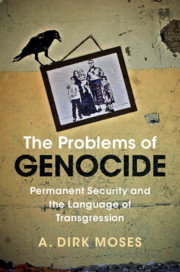Book contents
- The Problems of Genocide
- Human Rights in History
- The Problems of Genocide
- Copyright page
- Contents
- Preface
- Introduction
- Part I The Language of Transgression
- 1 The Language of Transgression, 1500s to 1890s
- 2 The Language of Transgression, 1890s to 1930s
- 3 Raphael Lemkin and the Protection of Small Nations
- 4 The Many Types of Destruction
- 5 Inventing Genocide in the 1940s
- Part II Permanent Security
- Part III The Language of Transgression, Permanent Security, and Holocaust Memory
- Index
1 - The Language of Transgression, 1500s to 1890s
from Part I - The Language of Transgression
Published online by Cambridge University Press: 07 January 2021
- The Problems of Genocide
- Human Rights in History
- The Problems of Genocide
- Copyright page
- Contents
- Preface
- Introduction
- Part I The Language of Transgression
- 1 The Language of Transgression, 1500s to 1890s
- 2 The Language of Transgression, 1890s to 1930s
- 3 Raphael Lemkin and the Protection of Small Nations
- 4 The Many Types of Destruction
- 5 Inventing Genocide in the 1940s
- Part II Permanent Security
- Part III The Language of Transgression, Permanent Security, and Holocaust Memory
- Index
Summary
Genocide is a problem: not only the terrible fact of mass death but also how the relatively new idea and law of genocide organizes and distorts our thinking about civilian destruction. Taking the normative perspective of civilian immunity from military attack, this book argues that the implicit hierarchy of international law, atop which sits genocide as the “crime of crimes,” blinds us to other types of humanly caused civilian death, like bombing cities, the “collateral damage” of missile and drone strikes, blockades, and sanctions. In other words, talk of genocide functions ideologically to detract from systematic violence against civilians perpetrated by governments. The Problems of Genocide also contends that this violence is the consequence of “permanent security” imperatives: the striving of states, and armed groups seeking to found states, to make themselves invulnerable to threats. To solve the problems of genocide, this book proposes replacing it with permanent security, which should be criminalized.
- Type
- Chapter
- Information
- The Problems of GenocidePermanent Security and the Language of Transgression, pp. 49 - 93Publisher: Cambridge University PressPrint publication year: 2021



